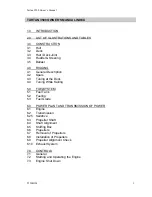
1-10
210 Montauk
Section 1• Safety
R
c
apsizing
• “Capsized” is when a boat is on its side or
completely upside-down (usually as a result
of wave action, improper loading or
load shifting).
• Always wear your PFD, or have it within
reach.
• If the boat will not right itself, get out of the
water and climb onto the exposed hull.
• Do a head count of all passengers
•
STAY TOGETHER
• Usually a capsizing will happen quickly and
without warning.
• Use whatever is at hand to signal for help.
• Fires can spread quickly. Your reaction
to the fire is important. Have the proper
fire fighting equipment close at hand,
and in good working order to respond
quickly.
• Small fire extinguishers have small
discharge times. Aim at the base of the
fire with a sweeping motion to maximize
the use of the fire extinguisher contents.
!
DANGER
Flooding, Swamping and Capsizing
In the event of Flooding, Swamping or Capsizing:
F
Looding
• Always wear your PFD, or have it within
reach.
To lessen the danger of fire:
• Extinguish all smoking materials, shut off
blowers, stoves, engine(s) and generator(s).
• Keep bilge area clean, oil and fuel spills should
be cleaned immediately.
• If possible throw burning materials overboard.
• If fire is accessible, release the contents of the
fire extinguisher(s) into the base of the fire.
• If the fire is in an enclosed compartment, and
you have an automatic extinguisher for the
compartment, wait 15 min. before opening the
compartment. Have an extinguisher handy in
case of a flare up.
• If possible, signal for help. Radio, visual, or
audible signal should be used as needed. You
must render assistance to any boater requesting
help.
• If fire is out of control, grab all necessary
survival gear, distress signals, don your PFD
and prepare to abandon ship.
• If you do abandon ship, make sure the
passengers have PFDs. Take a head count
before entering the water and take another
head count when in the water.
STAY
TOGETHER.
• If the bilge pump(s) have not automatically
turned ON, switch them ON immediately.
• Find the source of the flooding and determine
the best fix.
• Keep the bilge pump running until the flooding
is under control.
• Call for assistance if the source of the flooding
cannot be controlled.
• Head back to port if possible.
s
wamping
• Always wear your PFD, or have it within
reach.
• Swamping is usually a result of wave action,
immediately get control of the helm and turn
the boat into the waves.
• Swamping can also be caused by an overloaded
boat.
• If the bilge pump has not automatically
turned ON, switch it ON immediately.
• The deck scuppers on your boat are designed to
drain the deck of water.
• Keep the bilge pump running until the flooding
is under control.
• Take a head count of all passengers.
Summary of Contents for 210 Montauk
Page 1: ...210 Montauk Owner s Manual ...
Page 43: ...1 22 210 Montauk Section 1 Safety R THIS PAGE INTENTIONALLY LEFT BLANK ...
Page 94: ...4 7 210 Montauk Section 4 Electrical System R 12 VDC Wiring Diagram Sheet 1 Fig 4 7 1 ...
Page 95: ...4 8 210 Montauk Section 4 Electrical System R 12 VDC Wiring Diagram Sheet 2 Fig 4 8 1 ...
Page 98: ...4 11 210 Montauk Section 4 Electrical System R T Top Harness Fig 4 11 1 ...
Page 99: ...4 12 210 Montauk Section 4 Electrical System R THIS PAGE INTENTIONALLY LEFT BLANK ...
Page 111: ...5 12 Section 5 Care Maintenance R 210 Montauk Reinforcement Location Diagram ...
Page 113: ...5 14 Section 5 Care Maintenance R 210 Montauk THIS PAGE INTENTIONALLY LEFT BLANK ...
















































